CAMPHER Lorenz and Ansela van de Kaap
Ansela’s origin
 Recent mitochondrial DNA analysis of two matrilineal descendants of Ansela van die Kaap has indicated that the Campher stammoeder’s maternal line is African. Her descendants have been identified as belonging to African mitochondrial haplogroup L0a1b2. (GENI “South Africa mt-DNA female progenitors” project, https://www.geni.com/projects/South-African-mtDNA-Female-Progenitors/17863 )
Recent mitochondrial DNA analysis of two matrilineal descendants of Ansela van die Kaap has indicated that the Campher stammoeder’s maternal line is African. Her descendants have been identified as belonging to African mitochondrial haplogroup L0a1b2. (GENI “South Africa mt-DNA female progenitors” project, https://www.geni.com/projects/South-African-mtDNA-Female-Progenitors/17863 )
This is in line with Dr Helena Sheffler’s conclusion in her 1991 research – that Ansela’s mother came to the Cape from West-Africa. (Sheffler, History of Muratie, Chapter 1: Pioneer from Pomerania. First owner Lourens Campher, p5-35, 1991).
Further confirmation appears to be found in the 1693 Lodge Census (Shell, Dr. RCH, Changing Hands : A Calendar of Bondage, 2008). In it on 1/1/1693 a Company slave labourer Ansiela van der Kaap is listed as a locally born half-cast slave of African origin.
In 1658 two large groups of slaves from West-Africa were brought to the Cape. On 28 March 174 slaves arrived from Angola in the Amersfoort, and on 6 May the Hasselt arrived with 228 slaves from Popo, Guinea. (Bauermeester EM, Die Kaapse slawe in kultuurhistoriese perspektief-1652-1838, 2002, MA dissertation, University of Pretoria, http://repository.up.ac.za/handle/2263/29316 ):
It seems before the Amersfoort and Hasselt arrived from Angola and Guinea with these large groups of West-Africans, there were very few slaves at the Cape, including only 4 females from African descent:
1653 Abraham van Batavia
1654 Eva and her son Jan Bruyn from Madagascar
1654 Anthony
1656 Catharina van Bengale
1657 (Feb) Angela van Bengale with daughter Anna de Koning
1657 (Mar) 2 slave girls Cornelia (10) and Lysbeth (12) from Abyssinia (Ethiopia)
1657 (Mar) 1 slave girl kleine Eva (5) from Madagascar
[the 3 young slave girls were likely placed in van Riebeeck’s household]
http://www.sahistory.org.za/article/first-slaves-cape
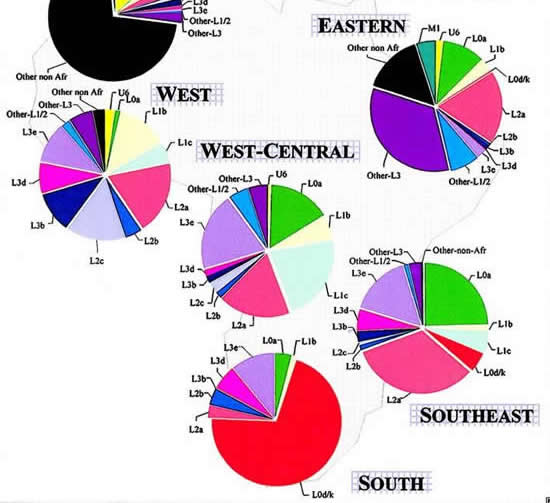
Haplogroup L0a and L0a1 individuals have been identified in both Guinea and Angola.
Figure 1 from The African Diaspora: Mitochondrial DNA and the Atlantic Slave Trade by Salas et al (2004) at http://www.ncbi.nlm.nih.gov/pmc/articles/PMC1182259/ L0a (bright green) is more abundant in west central Africa (north of Angola and south-east of Guinea) than in either of those places or South Africa. L0d and L0k are the predominant southern African haplogroups (red).
Makro haplogroup L0 originated in east Africa and spread south- and westwards. L0a reached Guinea 4000-10000 years ago https://en.wikipedia.org/wiki/Haplogroup_L0_(mtDNA) One will thus expect L0a1b2 to be more recent in the western region.
According to a South African geneticist who had been consulted, there is currently insufficient complete genome data available for African mt-DNA to compare Ansela’s complete L0a1b2 genome with, and attempt to identify a more specific origin. However, increasing availability over time of data for complete mitochondrial genomes in Africa may make this possible at a future date.
A descendant of one other slave Regina van Guinea has also been identified with mt-haplogroup L0a1b2. https://www.familytreedna.com/public/CapeDutch?iframe=mtresults Ansela van die Kaap and Regina van Guinea would have shared a common ancestor.
Of the West-African slaves that arrived in 1658, 60 were allocated to the slave lodge (likely including Ansela's mother), 172 were sent on to Batavia, 79 were sold to company officials and 51 to vryburgers (W Blommaert, Het invoeren van de slavernij aan de Kaap, argief jaarboek vir Suid-Afrikaanse geskiedenis, 1938)
Ansela would have likely have been born in the late 1660’s (her first child baptised 1686). After the arrival of the West-African slaves in 1658, slave trade stopped for 2 years and only resumed in 1660 [W Blommaert, Het invoeren van de slavernij aan de Kaap, argief jaarboek vir Suid-Afrikaanse geskiedenis, 1938]
The slave transactions recorded by both Dr Boeseken and Dr Robert Shell from 1658-1662 include ONLY West-African slaves from Angola and Guinea except for 2 Creoles recorded in 1661 by Robert Shell. Between 1662 – 1676 there are still West-African slaves being traded, but they are joined by others from the East – eg Ceylon, Batavia, Bengal, many areas in India and Indonesia. The first time a slave transaction from East-Africa (Madagascar) is recorded by both Boeseken and Shell is in 1676 – likely some years after Ansela’s birth. These officially recorded slave transactions are of course by no means a complete list – but they nevertheless paint a very clear picture in this regard.
As far as African slaves went, those from West-Africa thus predominated until the mid 1670’s, well after Ansela’s birth. So considering all the above, we can be reasonably confident that Ansela’s mother would likely have been brought to the Cape from West-Africa in 1658.
Two Ansela’s
Ansela’s name has been spelt Ansla, Ansilla, Ansala, Angela, Hansla, Hansela, Hansala, Hanselaar, possibly also Anzela. Ansela is used most often.
There was another female slave with a similar name at the Cape at the time. From the ‘’rolle van vrije luijden’’ Distric t van Stellenbosch, 1695 we find:
• Stellenbosch: Laurens Campe en Ansela van de Caab, 3 k. (Lourens signs a loan document in the Cape in 1676, appears as single in a Stellenbosch Opgaafrol 1688 (Sheffler, 1991), in the Stellenbosch monsterrolle of 1690 and 1691, and with Ansela + 3 children from 1695 onwards)
• Drakenstein: Hans Silberbagh en Angela/Ansela van de Caab, 1k (Hans appeared as single in Stellenbosch 1685, district unspecified 1686, single in Drakenstein in 1690 -1693, and in Drakenstein with Angela/Ansela + 1 child 1695)
Silberbagh was banished from the Cape in 1697 and never heard of again. What happened to his Ansela van die Kaap and her child is unknown.
According to dr. J Hoge in "Personalia of Germans at the Cape" HANS SILBERBACH was burgher at Stellenbosch (1685) and Drakenstein (1693), ~ Ansela of the C. One child, name unknown. (MR: Vrye Lieden of 1685 and 1693.). On 6.7.1697 he slew the burgher, Ary Lecrévain (Lekkerwyn) with a stick and escaped. (C 681, p. 247.) He was summoned to appear within eight days at the Castle (ibid., pp. 250 ff.), and when he did not come he was declared “veldvlugtig en vogelvry” and banished for life; in case he should be found he would suffer the death penalty. His estate was confiscated (C 681, p. 261) and his house sold by public auction on 8.11.1697. (C 728, p. 65.)
Only one of these Ansela’s van die Kaap was a Company slave when the 1693 slave lodge Census was recorded on 1 January. Since all 3 her children were also recorded in this census, we can be confident that this Ansela was the one that went on to become the Campher stammoeder.
Ansela’s early Years
As a baby Ansela would have lived with her mother in the slave quarters under the granaries of van Riebeeck’s clay fort (on the present Parade). After the new slave lodge near the Company gardens was completed in 1679, Ansela and later her children too would have lived there.
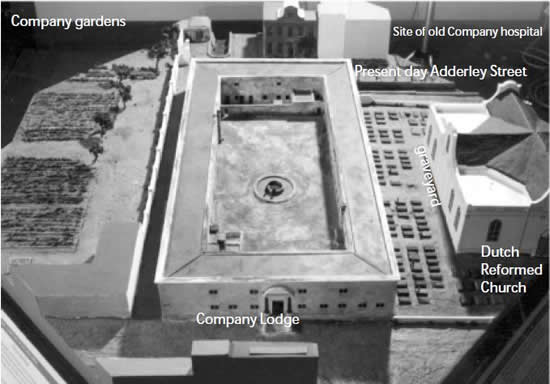
Model shown in The Lodge Women of Cape Town, 1671 to 1795 by Prof. Robert C.-H. Shell (source: South African Cultural Musem, Peter Laponder, model maker)
Like most female slaves, Ansela may have worked in the company garden. (Böeseken, dr. AJ (1977). She was recorded in the 1693 Census as a labourer (Shell Dr. RCH, Changing Hands : A Calendar of Bondage, 2008).
Children
Lourens Campher and Ansela van die Kaap lived in Stellenbosch on the farm De Driesprong for most of their lives, raising the 3 children born in the slave lodge prior to Ansela’s manumission:
• Cornelis, baptised 27/10/1686
• Angenietie, baptised 29 January 1690, with 6 other Company slave-children
• Jacoba (“kastijse” – ¾ European) baptised on Sunday 7 September 1692, also with 6 other Company slave-children.
As was the custom at the christening of Company slave children, the father’s name was not recorded in the church register.
All 3 these children, like Ansela, appear in the 1693 Slave Lodge Census (Shell Dr. RCH., Changing Hands : A Calendar of Bondage, 2008):
• Cornelis, male, child, casties, scholar
• Angenitje, female, child, half-cast, scholar
• Jacobje, female, suijgeling, half-cast, dependent infant
This information agrees reasonably well with the baptismal records of Company slave Ansela’s children. It does raise the possibility that Ansela’s second child Angenitje/ Angenietie may have been a toddler rather than a baby in 1690 when she was baptised, for her to be in school in 1693.
It also highlights that the racial classification so prevalent at the time was very subjective, with Jacoba being clasified “castijs” by the minister who baptised her in Sept 1692, and “halfslag” by the person who recorded the 1693 census in the slave lodge. It was likely based on how the person recording the information interpreted features including skin colour. It can not be considerd accurate.
Dr Sheffler felt convinced that Lourens Campher met Ansela van die Kaap prior to 1686 and that he was the father of all 3 Ansela’s children. This is of course possible but to date no documentarty evidence that this was definitely the case has been uncovered. We are also unable to use DNA evidence to investigate this further since Lourens and Ansela did not have any more children together after she joined him in Stellenbosch in 1695.
Lorenz/Laurens/Lourens Campher
Campher is believed to be a German from Morrouw/Mohrow in the former Pomerania, a historic region of north-eastern Europe. It’s situated on the Baltic Sea and most of it today is part of Poland.
According to Dr J Hoge’s Personalia of the Germans at the Cape: LORENZ CAMPHER (signature of his children Kamfer).- According to CJ 1254: 107 of “Morrouw” (i.e. Mohrow in Pommerania ?) Burgher of Stellenbosch, owner of the farm “Murasie” near Koelenhof. ~ Ansela of the C. Children: Cornelis
(13.10.1686, see G.R. nr. 73), Agnitie ~ Gerrit van der Swaan, Antoinetta ~ (1) Ary v. Wyk, (2) Joachim Scholtz (q.v.); Jacoba ~ (1) Joost de Klerk, (2) Christoffel Ameen (q.v), (3) Rudolph Frechen (q.v.). (MR. Vrye Lieden of 1695 and 1.700.)
We know Lourens was already at the Cape in 1676 when he negotiated a loan at the Castle. [KAB: CJ 2750 Procuratien 1686-1694:102]. Lourens was apparently illiterate, he signed this agreement only with a cross. (Sheffler, 1991)
Since the majority of the early immigrants came to the Cape as soldiers or seamen (Heese, 1984) it can be assumed that Campher also followed one of these callings. It seems he settled originally in Tafelvallei where he presumably would have met the young Company slave girl Ansela.
It seems Lourens could have been living on the farm De Driesprong since 1685 (Fransen and Cook: The old Houses of the Cape, 1965) when it was promised to him by Governor Simon van der Stel (Van der Byl,1963). He is recorded as single in the 1688 Stellenbosch Opgaafrol (Sheffler, 1991: IHN Opgaafrol 1688) and the 1690, 1691 and 1693 monsterrolle. From1695 onwards he is recorded with Ansela and their children.
Exactly what he was doing is unknown, but a reference has been found in the “Stellenbosch Kasboek” of Lourens also working there as a ‘messelaar” – mason/bricklayer. (Corney Keller: 1 STB 12/15 for the year 1704).
The De Driesprong’s title deed was officially signed over to Lourens on the last day of February1699 by governor Willem Adriaan van der Stel. He may have lived there on and off since 1685 but only farmed the land since 1696 as indicated in his 1716 tax return (Sheffler, 1991)
The Stellenbosch citizen Force which Lourens belonged to exercised annually in the Cape [Smuts 1979]. Campher may have visited Ansela on these and other occasions.
Manumission
Manumission was conditional on the woman being able to speak Dutch, profess the Christian faith and be a member of the Church. (De Wet, 1981) [Quoted as some van Rheede’s conditions of manumission after 1685 by Robert Shell in his book Children of Bondage p344, GC de Wet’s Vryliede en Vryswartes in die Kaapse Nedersetting p206, and Dr Boeseken in Slaves and Free Blacks p82].
The baptism of an adult female slave Angela is recorded on 19 June 1695 (een bejaerd persoon nae voorgaende belijdenisse gent: Angela van de Caap). Influential Christina Diemer (daughter of German Elbert Diemer, late member of the Burgher Council ) also attended this ceremony, as witness to the baptism of the son of Jan Wessels and Helena Wijnands.
Nine days later on 28 June 1695 her mother Christina Does (widow of Elbert Diemer) manumited a slave called Anzela van die Kaap (Transporten en Schepenkennis Vol 11).
These two events may have involved the same or different Ansela’s.
Lourens Campher’s Ansela joined him in Stellenbosh in 1695 (Opgaafrol), so she was definitely manumitted around 1695.
Dr. Sheffler believed that the Ansela owned by Christina Does (widow Diemer) was taught to read and write by her, was the same Ansela who was baptised on 19 June 1695, manumitted by her on 28 June 1695, and she was Lourens Campher’s Ansela. This is however an assumption and may not be correct.
According to the VOC baptismal policy which was based on the decisions made during the Synod of Dortd in 1618, all slaves born in the slave lodge had to be baptised. (Paths to Freedom: Manumission in the Atlantic World by Rosemary Brana-Shute, Randy J. Sparks, p106, 2009)
Since Ansela was a VOC slave born at the Cape according to the 1993 lodge census, one would expect her to have been baptised young, making it seem more likely that the Ansela baptised on 19 June 1695 was not the Campher stammoeder.
Whether or not the Ansela who was manumitted on 28 June 1695 was another Ansela or the Campher stammoeder is uncertain. It is possible that Mrs Diemer purchased Lourens Campher’s Ansela from the VOC after 1/1/1693, and manumitted her on 28 June 1695.
Marriage
Dr Sheffler believed that Lourens and Ansela had been married, although no record of the ceremony can be traced in Stellenbosch or the Cape (Unfortunately the Drakenstein records had not survived).
Their marriage could also have been a civil ceremony by the “Raad”. Unfortunately the Matrimonial Court records also have not survived. (Corney Keller)
Lourens and Ansela are recorded as husband and wife in opgaafrolle (eg 1700,1713), and after Campher’s death she was referred to as his widow. (Sheffler, 1991)
Life in Stellenbosch
Around 1695/6, the Campher family went to live on De Driesprong. Lourens not only sought a picturesque place for the homestead, but a practical one as well. Their home (originally a thatch cottage) was built on a rise near the mountain stream, beyond the reach of flood waters but near enough for the purpose of fetching water. There was a small drift and convenient scooping place just below the house. The house had an excellent view of Simonsberg and down the valley Table Mountain could be seen in the distance. (Sheffler, 1991)
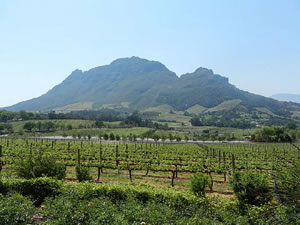
View of Simonsberg from Muratie (originally De Driesprong)
It must have been very exciting for the slave girl to be free, to marry Campher and be able to live with him and their children in their own house. After life in the slave lodge, this humble dwelling must have felt like a palace. (Sheffler, 1991)
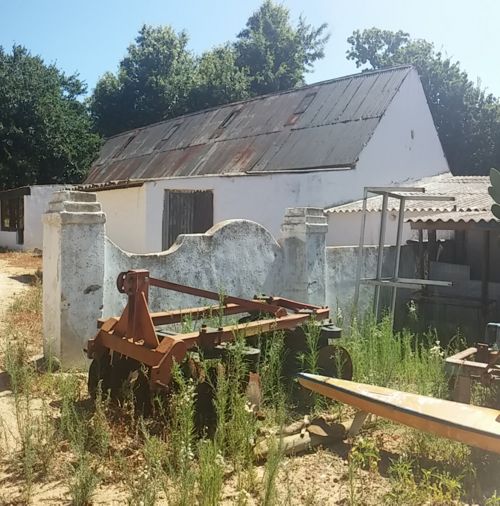
Campher homestead at De Driesprong (Wikitree: Ansela van de Caep)
At this time there were comparatively few marriageable women at the Cape and there were accordingly in 1700 several mixed couples. Freed slaves were well-received in the social and economic life of the settlement and were not seen as a separate group isolated from the free-burghers. (Heese, 1984)
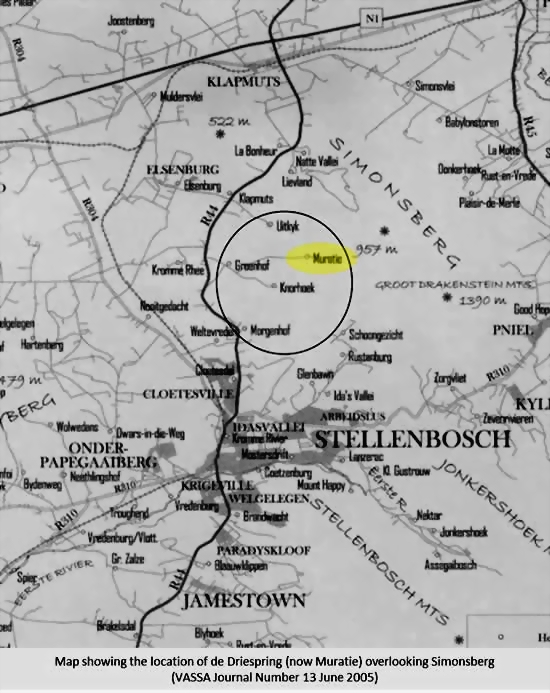 here
here
Later Years
Lourens, Ansela and later their son and his family lived and farmed at De Driesprong. They did all their farm work themselves and struggled to make a living some years according to tax registers.
In time all 3 Campher children grew up and got married:
• Cornelis x 7 Jan 1709 Dorothea Oelofe,
lived and farmed on De Driesprong with his parents
• Angenietie (Agnietie, aka Antoinetta)
x 5 Sept 1705 Gerrit v d Swaan
xx 27 Dec 1711 Arij van Wyk
xxx 31 Mei 1733 Joachim Scholtz
• Jacoba
x 10 Nov 1711 Joost de Klerck,
xx 13 Des 1713 Christoffel Ameen,
xxx 17 Jun 1725 Rudolf Freschen
During 1720 Lourens gave up farming. He died 9 years later between 3 May 1729 and 1 may 1730. He is probably buried in the new churchyard in Drosdy street in Stellenbosh. (KAB: J 187 Stel 1729; J 188 Stel 1730) (Sheffler, 1991)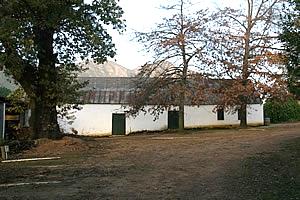
Campher homestead at De Driesprong
(David Ellis: Historic Muratie Wine Estate A Vintage Tale)
If we assume that Lourens was 22 when he negotiated his first loan at the Castle, he would have been 75 when he died.(Sheffler, 1991)
Cornelis continued to farm for another 5 years before the farm was sold. During the last year (1734) he had to manage without a single ox, planting 1000 vines and sowing 2 muids of corn. By November he was too sick to take part in the military exercises on the Braak, and he and his mother must have decided to give up the struggle. (Sheffler, 1991)
Ansela sold De Driesprong for 2500 Cape guilders cash to farmer Conrad Samuel Rudeman on 25 February 1735. (Transfers 44: T2230; KAB: 1/Stb 13/22 1734).
It is noted here that Ansela was literate –she signed the sale document in her name. (Sheffler, 1991). It is not certain whether Ansela would still have been school age in 1685 and was taught to write in the school founded in 1685, or whether she was taught to write by someone else, possibly the person who manumitted her.
[In 1658, the first school for slave children was started by Pieter van Stael, the local sick comforter and brother-in-law of the first Dutch commander, Jan van Riebeeck. However, this school did not last for long and another attempt to establish a school was only made in 1685 after the slaves were moved to the slave lodge….Children from the Lodge younger than 12 attended the school while children between the ages of 12 and 16 attended school two afternoons a week for religious instruction. (Heritage of Slavery in South Africa – Slave Lodge http://media1.mweb.co.za/iziko/sh/resources/slavery/slavelodge_life.html )
In 1735 Cornelis again could not attend the military manouvres, and by the year after he was deceased. (KAB: 1/Stb 13/22 Stel 1735 & 1736) Cornelis died between 3 May and 1 November 1736 aged 50. His eldest children were then in their twenties and his youngest daughter only 7 (Sheffler, 1991).
The Camphers had lived on De Driesprong for 39 years. After the sale of the farm Ansela was a relatively wealthy woman (2500 guildres was equivalent to 23 years’ salary for a seaman or soldier). It’s thought she probably went to live with one of her daughters (Sheffler, 1991).
Compiled by Martina Louw, Apr 2016.
Reviewed by Corney Keller and Rassie Rascher.
- Hits: 24421